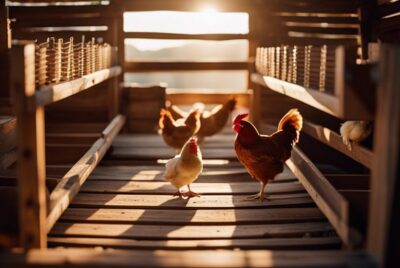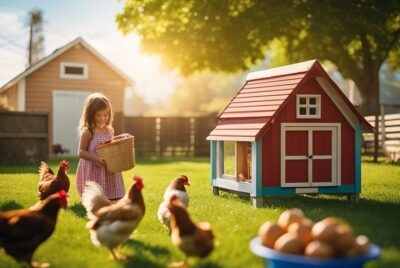Nesting Boxes – Creating Comfortable Laying Spaces
Boxes play a crucial role in ensuring that your hens have a cozy and comfortable space to lay their eggs. Providing well-designed nesting boxes can not only encourage your chickens to lay consistently but also help to keep their eggs clean and secure. This blog post will explore the essential elements of creating nesting boxes that promote a stress-free environment for your feathered friends, ultimately leading to healthier and happier hens.
Understanding the Needs of Laying Birds
Physical Comfort Requirements
To understand the needs of laying birds, it is essential to consider their physical comfort requirements. Laying hens, for example, need a comfortable and clean space to lay their eggs. Providing nesting boxes that are well-padded with soft material such as straw or shredded paper can help ensure that the hens have a cozy spot to lay their eggs. The nesting boxes should also be adequately sized to allow the hen to turn around and adjust herself comfortably.
Proper ventilation is also crucial for the physical comfort of laying birds. Adequate airflow helps maintain optimal temperature and humidity levels in the nesting boxes, creating a conducive environment for the hens to lay their eggs. Additionally, ensuring that the nesting boxes are placed in a quiet and secluded area can help reduce stress in the birds, further enhancing their physical comfort.
Behavioral and Psychological Considerations
Any discussion on the needs of laying birds must also include considerations for their behavioral and psychological well-being. Laying hens are naturally inclined to seek out private and secure spaces to lay their eggs, as it is an instinctual behavior rooted in their biology. Providing nesting boxes that offer privacy and protection can help alleviate stress and encourage natural laying behaviors in the birds.
Understanding the social dynamics within a flock is also important when considering the behavioral and psychological needs of laying birds. Dominance hierarchies can influence where and when hens choose to lay their eggs. By observing and understanding the interactions between birds in a flock, one can better cater to their individual needs and preferences, ultimately promoting a harmonious laying environment.
Designing and Building Nesting Boxes
Some of the most crucial elements of creating comfortable laying spaces for your poultry are the design and construction of nesting boxes. By providing a cozy and secure environment for your hens to lay their eggs, you can ensure their well-being and productivity. In this chapter, we will explore the key considerations for designing and building nesting boxes that meet the needs of your flock.
Selecting the Right Materials
An essential first step in designing nesting boxes is selecting the right materials. The ideal materials for nesting boxes are sturdy, easy to clean, and provide insulation and comfort for your hens. Some common choices include wood, plastic, or metal. Make sure the materials you choose are non-toxic and safe for your birds.
When selecting materials, consider factors such as durability, cost, and ease of maintenance. Choose materials that are resistant to moisture and can withstand the wear and tear of daily use. Additionally, opt for materials that are easy to clean to ensure a hygienic environment for your hens.
Step-by-Step Construction Guide
For those looking to build their nesting boxes from scratch, here is a step-by-step construction guide to help you create the perfect laying space for your flock:
| Step | Instructions |
| 1 | Gather materials and tools needed for the project. |
| 2 | Measure and cut the materials according to the desired dimensions of the nesting boxes. |
| 3 | Assemble the pieces together using screws or nails to create the box structure. |
| 4 | Add a sloped roof to prevent perching and ensure privacy for nesting hens. |
Building your nesting boxes allows you to customize them to meet the specific needs of your flock. Whether you have limited space or a large coop, designing and constructing your nesting boxes provides an opportunity to create a comfortable and functional laying area for your hens.
Additional Tips
For those looking to begin on the construction of nesting boxes, consider the following additional tips to ensure a successful project:
| Tip | Recommendation |
| 1 | Ensure proper ventilation in the nesting boxes to prevent moisture buildup. |
| 2 | Line the nesting boxes with soft bedding material such as straw or wood shavings for added comfort. |
Installation and Maintenance of Nesting Boxes
Proper Placement for Maximum Utility
Despite their simple appearance, nesting boxes play a crucial role in providing a comfortable and secure space for your poultry to lay their eggs. When installing nesting boxes, it is important to consider the preferences of the birds. Placing the boxes in a quiet and dimly lit area can help create a peaceful environment that encourages nesting behavior.
Nesting boxes should also be positioned at a height that is easily accessible to the birds but out of reach from potential predators. Additionally, ensure that the boxes are well ventilated to maintain a clean and healthy environment for your birds.
Keeping Boxes Clean and Inviting
Nesting boxes should be cleaned regularly to prevent the buildup of dirt, droppings, and parasites that can deter birds from using them. Remove any soiled bedding and replace it with fresh, clean nesting material such as straw or wood shavings.
Proper maintenance also involves inspecting the boxes for any signs of damage or wear and tear. Repair or replace any broken parts to ensure that the nesting boxes remain sturdy and inviting for your birds.
Boxes that are dirty or crowded may discourage birds from using them, leading to eggs being laid in undesirable locations. Maintaining clean and inviting nesting boxes is essential to ensure the health and productivity of your flock.
Troubleshooting Common Issues with Nest Boxes
Addressing Underuse or Overcrowding
The comfort and functionality of nest boxes are crucial for their effective use by your birds. If you notice underuse or overcrowding in your nest boxes, consider checking the size and design of the boxes. The space should be neither too small nor too big for the specific species you are catering to.
Additionally, ensure that the nest boxes are placed in a quiet and secluded area. Birds prefer privacy when laying eggs, so providing a peaceful environment can encourage them to use the boxes more regularly. Regularly cleaning the nest boxes and replacing old bedding can also help in promoting their use.
Repelling Pests and Predators
One of the common issues with nest boxes is the invasion of pests and predators, which can put your birds’ safety at risk. To address this, choose materials for the nest boxes that are sturdy and cannot be easily accessed by predators like rodents or snakes.
Installing predator guards around the entrance of the nest boxes can also help in deterring unwanted visitors. These guards can be in the form of metal plates or wire mesh that prevent predators from reaching the eggs or young birds inside the boxes.
This ensures that your birds can safely and comfortably use the nest boxes without the threat of external dangers.
Final Words
With this in mind, nesting boxes are crucial for providing chickens with a comfortable and safe space to lay their eggs. By creating well-designed nesting boxes, you can ensure that your hens will be happy, stress-free, and more productive in laying eggs. Remember to provide clean bedding, proper ventilation, and privacy for your chickens to encourage them to use the nesting boxes regularly. Investing time and effort in creating comfortable laying spaces for your hens will result in healthier and happier birds, as well as a consistent supply of fresh eggs for you to enjoy.



